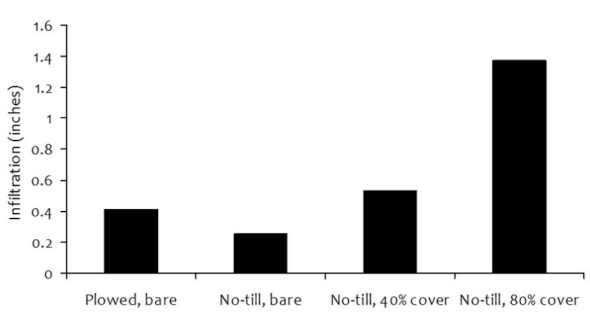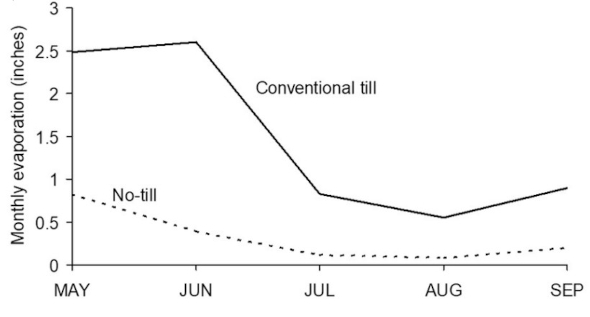By Sjoerd Willem Duiker
The water balance equation is a useful tool to evaluate ways to improve water use efficiency. The water balance equation states that:
Precipitation (P) + Irrigation (I) = Runoff (R) + Deep Drainage (D) + Evaporation (E)+ Transpiration (T) ± Soil Water Content (?S).
The water balance equation considers the crop and soil as a box with inputs and outputs, the inputs being P+I and the outputs R+D+ET and ?S soil water in the root zone a storage component. The components of the water equation are expressed in units of depth (such as inches or cm of water). Today we will start with R, D, and E.
R - Runoff
Runoff from our fields should be eliminated as much as possible so that all the water infiltrates in the soil where it can be used by the crop roots or recharge groundwater. The impact of the raindrops of intense rainstorms on bare soil results in soil sealing which increases runoff. These intensive rainstorms are most common in mid-late summer, but also occur in spring. As our climate warms we are expecting more intense rainstorms in the future. With no-till crop residue at the soil surface protects the soil surface from the impact of the raindrops, which is the most important reason for higher infiltration in no-till than conventional tillage. The importance of crop residue is paramount – if that is not present runoff in no-till may be the same or even greater than in tilled soil (Figure 1). That’s why cover crops are so important after low-residue crops such as corn silage, soybeans, or small grains where straw is removed. Winter cover crops also help improve infiltration in the fall and winter and contribute to the mulch cover in the next crop (even if part of the cover is grazed or harvested for forage). Soil health improvement is important to increase aggregation and macroporosity for water percolation into and through the soil profile. This can be achieved by improvement of surface soil organic matter content (reducing tillage, returning organic matter such as manure to the soil, retaining crop residues), feeding biological life in the soil (for example earthworms make lots of macropores) and maximizing living root growth throughout the year. Avoiding surface soil compaction is important to avoid loss of macroporosity.

Figure 1: Infiltration differences between conventional tillage, and no-tillage with different levels of residue in a rainfall simulation study. The importance of residue cover to increase infiltration is clear.
D - Deep drainage and lateral flow
This is the water that leaves the root zone and enters into ground water or contributes to seeps, springs, and streams. Although this is a loss of water to our crops, it is important to recharge groundwater and streams. Since the soil is a great filtration system, it is much better to recharge groundwater and have it gradually feed streams than having water run off the soil surface. However, we may think about ways to avoid losing too much water ‘through the bottom’. A disadvantage of artificial drainage systems is that they discharge throughout the year, even when it might not be desirable. Controlled drainage technology closes the drains for parts of the year (for example in the summer when drainage is not needed).
E - Evaporation
This is the water that evaporates from the soil surface without contributing to plant growth. It is highest when the sun shines directly on the uncovered soil surface. To have mulch on the soil surface is a way to reduce evaporation. Research from Kentucky showed that much of the precipitation in May and June (before canopy closure) was lost from tilled soil, while it was much reduced in no-till with heavy residue (Figure 2). Again, residue cover is key, because the residue creates a blanket that avoids sunrays to hit the soil, and it also slows water vapor from leaving the soil surface. Planting green has shown to dramatically increase the amount of mulch during the summer, and to increase the duration of mulch cover because of higher C:N ratio of the cover crop. The living cover crop uses more water by transpiration in the spring so it depletes soil water at that time, but in summer the dead mulch conserves moisture by reducing evaporation. Another way to reduce evaporation is to quickly have canopy closure so that the soil surface is shaded – that’s where the benefit of early planting comes in so that the canopy is closed before the heat of summer. Another option is to use closer row spacing.

Figure 2: Research from Kentucky showed dramatic differences in monthly evaporation between no-till with high residue cover and conventional tillage where the soil was bare.
Source : psu.edu